


FARNBOROUGH PARISH REGISTERS
Farnborough became a full parish in 1876, with George William Hingston as Rector. Before that Farnborough was part of the larger and more populous parish of Chelsfield, sometimes having its own Rector. but more usually just a Curate.
This explains why the church at Farnborough is comparatively small, even though the population of Farnborough has grown significantly since the second world war, and is now similar to that of Chelsfield.
The Church is dedicated to St. Giles the Abbot, see the panel to the right.
For information about the history of the church, including registers from the time since it became an independant parish please refer to the Farnborough Parish website at www.farnborough-kent-parish.org.uk
Farnborough Parish Registers 1538 - 1652
The following article was prepared by Fred Whyler in 1997 for the Bromley Borough Local History Society, and is reproduced here by kind permission of the Society.As well as describing the registers themselves it contains a fascinating insight into village life at a time when the country was breaking with Roman Catholicism and plague was an ever present threat.
Farnborough was a chapel of Chelsfield until 1876, and is one of the
few parishes in the Diocese of Rochester that has kept both the earlier
(paper) and later (parchment) registers. The ‘paper’ register
was retained at Chelsfield after 1876, and this
has caused confusion, as the entries in this ‘paper’ register have been
recorded as belonging to Chelsfield and not Farnborough . In the
registers, baptisms are recorded from 1546 to 1645, with one entry' in
1652. Marriages are recorded from 1540 to 1645, and burials from 1538 to
1646, with again one entry in 1652. There are, alas, no entries at all
for some years.
The registers record about 450 baptisms, which gives an average of 5 or
6 a year. There are 124 marriages. January was the most popular
month to get married (20 of them); closely followed by October (17).
March was the least popular with only one marriage. There are 410
burials recorded
| The plague seems to have struck the village several times. In 1542, there were 11 burials (all but one in June and July). Five of them were of the Barton family and 3 of the Warners. It struck again in 1563, when there were 18 burials, all in July and August. There were 4 Beveridges and 5 Knights. In 1603/4 there were 16 burials over a period of 12 months, 13 being recorded as ‘plague’. Within two weeks John Rogers buried his wife and three children. There were 20 burials in 1624/5. In 5 cases the word ‘plague’ is written against the entry. In 1642, of the 12 burials, all but one have the word ‘plague’ |
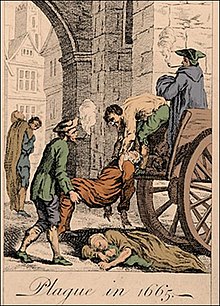 |
William King married Joane Burchct on 5th December 1581. She was buried on 21st April 1583, after less than 2 years of marriage. Less than 2 months later William married, on 9th June 1583 his second wife, Joanne Diplake. She was buried on 3 May 1599, and within 4 months, William married again, this time on 26th August, 1599, to Elizabeth Miller. William was buried on 15 May, 1617, aged 80. On 21st February, 1575, John, son of James Packham, as it is thought, and Agnes Bayley was baptised.
George Dalton, a benefactor, was buried on 11th January 1566. In his Will he left ten shillings to be paid for a sermon to be preached at Farnborough parish church, annually, and 3s 4d to be given to the poor of the parish for ever. The register does not say how he died, but there is a legend that he used to arrive at his house at ‘Tubbendence’ drunk . One night his wife refused to admit him. He wandered off. fell into a lake and was drowned . In my opinion, this sensational event in the village would have meant some comment in the register if true.
The village had a butcher, William Spur who was buried in 1592; an Inn (of course) whose landlord was probably John Letcot, who was buried in 1597; and a smith, Davy Miller, who was also buried in 1597. A number of villagers lived to be 80 and Juliana Netlingham was believed to be nearly 90 when she died in 1611/2. Ann Bevenge, a widow of 80 suffocated in a well in 1612. There are two references to men being killed by carts, and Thomas Butler fell out of a tree and died 6 days later. The burials of two parish clerks are recorded; Thomas Lane in 1588 and Thomas Philip in 1612. So the village was then sufficiently organised to have a parish council of some kind with an officiating clerk.
Henry VIII (1509 -1547) was on the throne when, under the orders of Thomas Cromwell, the Vicar-General, these registers were started in 1539. The Catholic religion and the local church then had a fairly strong hold over the beliefs and activities of the parishioners. In 1534, Henry pronounced himself head of the Church of England and put the authority of the monarch in place of that of the Pope. A Bible in English was provided in the church. The Latin Mass was replaced by a service in English and a new simple form of service was ordered. These changes did not meet with any opposition. Edward Powell, curate of Farnborough, signed the declaration ordered by Henry VIII that ’The Bishop of Rome hath no greater jurisdiction committed to him by God in the realm of England than any other foreign bishop’. It is doubtful if any of the parishioners understood the changes and they would not have cared very much anyway.
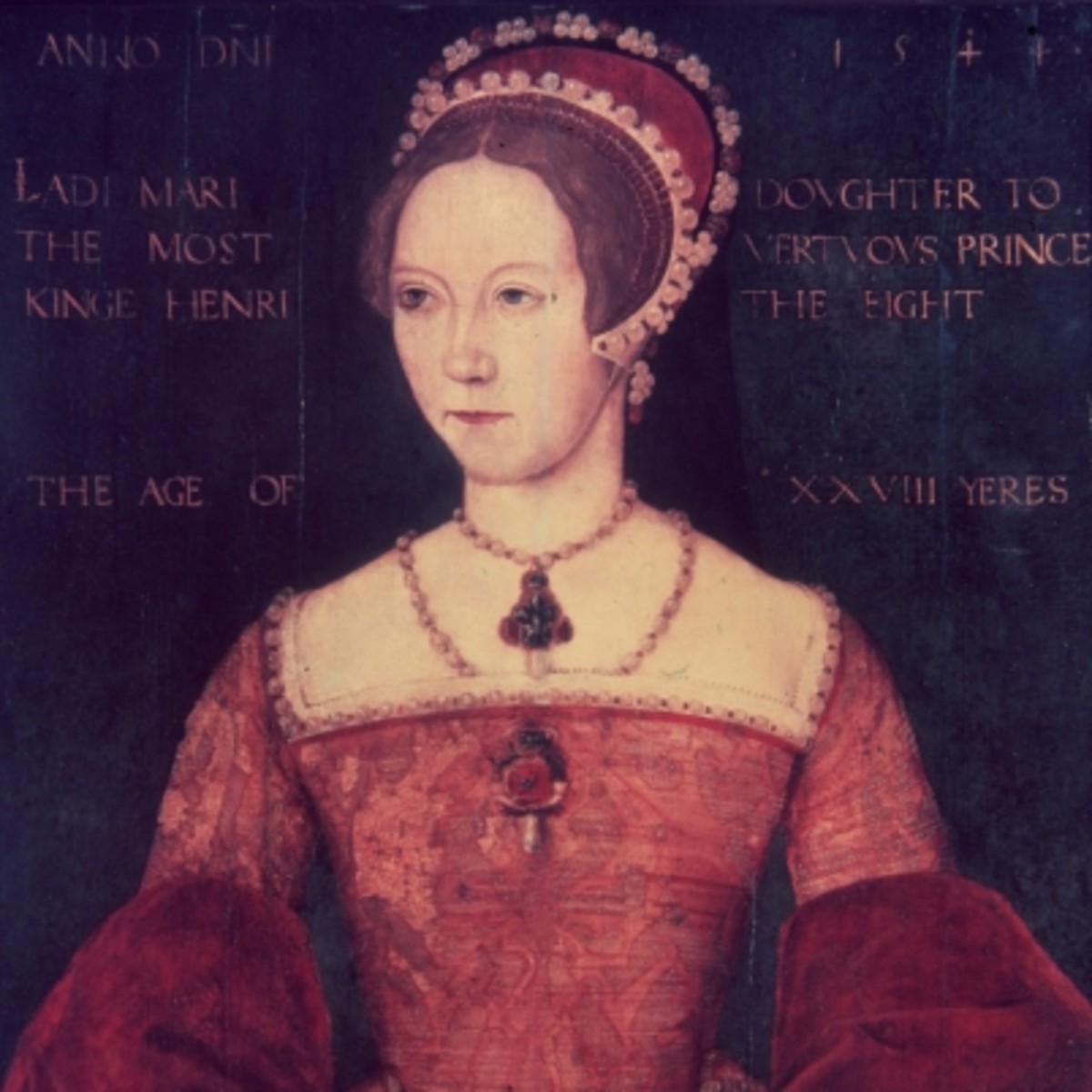 |
Under the reign of Henry’s son, Edward VI (1547- 1553) the parish church would have lost such treasures as it possessed on the grounds that they were not required for the services. Mary (1553- 1558 - left) restored the Roman Catholic faith. The parish church had to change its services again. Rood screens, vestments, Latin Service books and other equipment necessary for Catholic services had to be provided. |
When Elizabeth 1 (1558- 1603) succeeded to the throne , the religious legislation of Henry VIII was restored, and she became the head of the Church of England. The altar, statues, rood-screens etc., were again removed from the church. English Bibles and service books were used again. Ministers and parishioners who had been Catholics were now Protestants.
If there were any feelings about these changes they were not mentioned in the church registers. It was during the reign of Elizabeth that the parish became a unit of local government. It was charged with responsibility for its poor; the assessment and collection of the church rate; the control of vermin and the maintenance of roads and bridges. There is in existence a court roll of Farnborough covering 1408, which shows a manorial court with judicial and administrative powers.
These extensive changes all occurred during the years covered by these registers. It is doubtful if they affected the religious and superstitious beliefs held by the parishioners. They would have been far more concerned about the weather, the state of the crops and the constant threat of the plague
Fred Whylerby HENRY WILSON. Farnborough, 1903
From a publication entitled
"THE PARISH REGISTERS OF FARNBOROUGH, IN THE COUNTY OF KENT, From 1338
TO 1812.", EDITED BY HENRY WILSON, M.A., F.S.A. FARNBOROUGH LODGE,
KENT.1904.
The Farnborough registers which begin in 1558 are contained, so far as
they have been printed, in three volumes.
The first volume consists of 92 parchment pages, bound in vellum, 14.3
inches by 6, containing the entries from 1558 to 1747. There is a blank
from 1624 to 1660.
The second volume has 168 parchment pages, 12 inches by 7, bound in
rough calf. It has marriages from 1752 to 1791, christenings from 1749
to 1812, burials from 1752 to 1812, and beginning at the other end,
marriages from 1792 to 1800.
The third volume is of paper printed forms, 14.2 inches by 9, bound in
rough calf. It contains marriages from, 1793 to 1812. Only 11 pages are
used, the rest are blank.
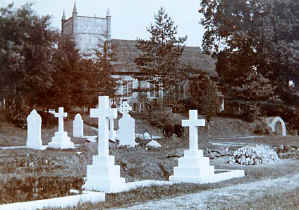 Henry Wilson's grave in Farnborough Churchyard |
After the above were printed and indexed, I found at the mother church of Chelsfield the Farnborough register from 1538 to 1557, and much of the interval between 1624 and 1660, though the later part was imperfect. These will be found on pages 152 to 163, and the index to them on pages 164 to 173 Henry Wilson |
FARNBOROUGH VILLAGE
About St. Giles
| St. Giles was born in the early 7th century and died c.710. His
Latin name was Aegidius. Little is known of his origin and early
life, but legend has it that he was born an Athenian and became
a hermit near the mouth of the Rhone, not far from Nimes. Legend also relates that whilst the King Wamba was out hunting in a forest he chased a hind who went into a thicket, into which the king shot an arrow. Upon investigating the King found Giles wounded by the arrow whilst protecting the hind. |
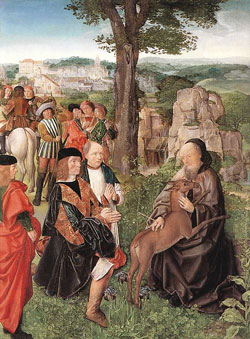
Giles founded a monastery at a place near Arles, which was later named Saint-Gilles (Provence). Towards the end of his life Giles went to Rome and offered the monastery to the pope who gave Giles two doors of cypress wood which Giles threw into the sea, but which were washed up on a beach near his monastery.
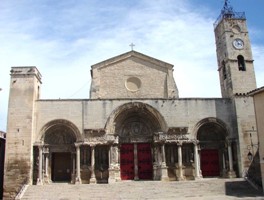
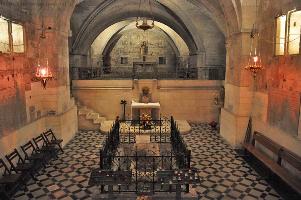
| Saint-Gilles Monastery, Arles (Provence) |
St. Giles became a popular saint in Western Europe due partly to the Crusaders who passed through Saint Gilles (Provence) on their way to the Holy Land. As a result of his encounter with King Wamba and becoming wounded and a cripple, St. Giles became the patron saint of cripples, lepers and nursing mothers.
In Great Britain alone over 150 churches and 25 hospitals are dedicated to his name, the most famous being in Edinburgh and Cripplegate London.
